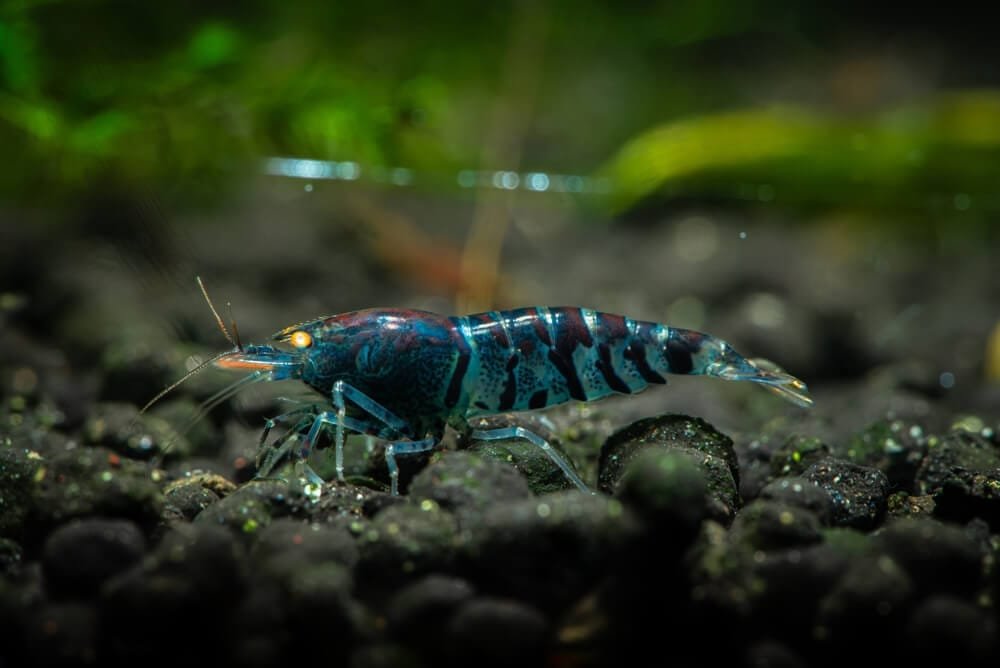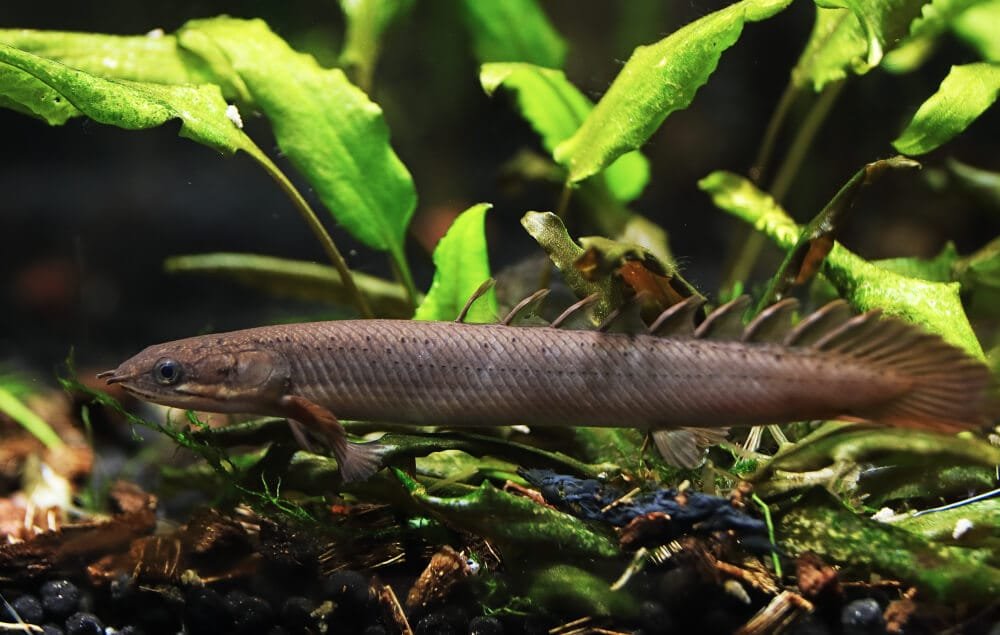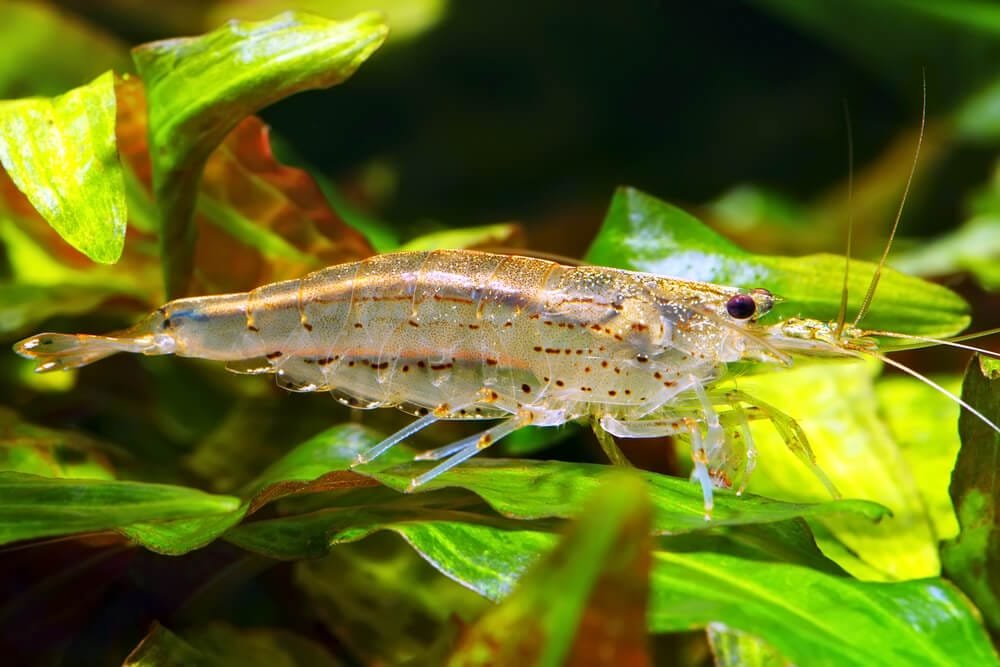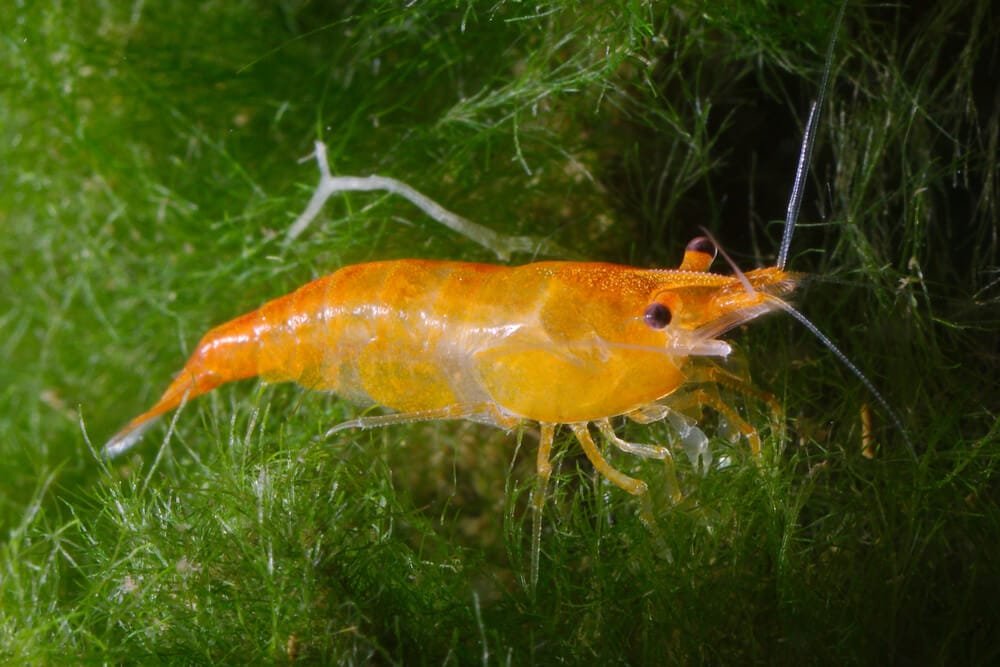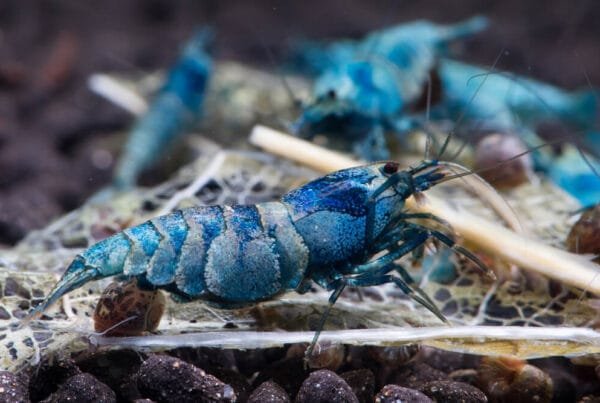Imagine having a splash of vibrant blue swimming in your aquarium – the Blue Tiger Shrimp (Caridina cf. cantonensis). These captivating creatures are a stunning addition to any aquatic hobbyist’s collection. With their striking blue coloration and distinctive patterns, the Blue Tiger Shrimp is guaranteed to become the centerpiece of your aquarium.
In this article, we will explore the unique characteristics of these fascinating creatures, including their habitat, behavior, and care requirements. So, get ready to dive into the world of the Blue Tiger Shrimp and discover why they are a must-have for any shrimp enthusiast.
Physical Characteristics
Blue Tiger Shrimp are a stunning freshwater crustacean species that are highly sought after by aquarium enthusiasts. As the name suggests, these shrimp display a vibrant blue coloration with dark stripes or spots. The intensity of the blue can vary, ranging from a pale sky blue to a deep sapphire hue. The body of the Blue Tiger Shrimp is typically translucent, allowing the vibrant coloration to stand out.
In terms of size, Blue Tiger Shrimp generally grow to around 1.5 to 2 inches in length. While they are not the largest shrimp species, their small size adds to their charm and makes them well-suited for a variety of aquarium setups.
The shape of Blue Tiger Shrimp is typical of shrimp species, with a curved body and a small yet noticeable tail. They have a flattened appearance, which allows them to easily navigate through plants and decorations in their environment.
Blue Tiger Shrimp have long and slender antennae that are highly sensitive to changes in their surroundings. These antennae serve as vital sensory organs, helping the shrimp detect food sources and potential threats. The antennae are also an important feature that contributes to the overall elegance of these beautiful creatures.
The eyes of Blue Tiger Shrimp are relatively large and situated on the sides of their heads. They provide these shrimp with excellent vision, allowing them to navigate their environment and identify potential predators or prey. The eyes are often a dark or black color, which adds to the striking appearance of the shrimp.
Habitat and Distribution
Blue Tiger Shrimp are native to Taiwan, where they inhabit the mountainous regions and freshwater streams. In their natural habitat, these shrimp can be found in areas with clean and well-oxygenated water. They tend to thrive in slightly acidic to neutral water conditions, with a pH range of 6.5 to 7.5. The water temperature should be maintained between 72°F to 78°F (22°C to 26°C).
In terms of distribution, Blue Tiger Shrimp are primarily found in Taiwan, but they have also been introduced to other parts of the world through the aquarium trade. Their popularity among aquarists has led to successful captive breeding programs, making them more readily available in the hobby.
Tank Setup
Creating a suitable tank setup for Blue Tiger Shrimp is crucial to their health and overall well-being. Paying attention to water parameters, aquarium size, substrate, plants and decorations, filtration, and water changes is essential for providing a conducive environment for these shrimp.
Water Parameters
Maintaining stable water parameters is of utmost importance when keeping Blue Tiger Shrimp. As mentioned earlier, they prefer slightly acidic to neutral water with a pH range of 6.5 to 7.5. The water temperature should be kept within the range of 72°F to 78°F (22°C to 26°C).
Aquarium Size
The aquarium size and setup should be appropriate for the number of shrimp you plan to keep. A tank with a minimum size of 10 gallons is recommended, as this provides ample space for the shrimp to move and exhibit natural behaviors. It is also important to include hiding places and ample swimming areas to accommodate their needs.
Substrate
When choosing a substrate for the tank, a fine-grained substrate like sand or gravel is ideal. This will allow the Blue Tiger Shrimp to forage and scavenge without injuring themselves. Avoid using sharp or rough substrates that may damage their delicate bodies.
Plants and Decorations
Including live plants and decorations in the tank not only enhances its visual appeal but also provides a natural environment for the Blue Tiger Shrimp. Plants such as Java moss, Anubias, and Amazon sword are great options and will provide cover for the shrimp to feel secure. Driftwood and rocks can also be added for additional hiding places.
Filtration
Filtration is vital for maintaining clean and healthy water in the tank. A reliable aquarium filter that provides both mechanical and biological filtration is recommended. It is important to ensure that the filter intake is covered with a fine mesh to prevent the shrimp from getting sucked into the filter.
Water Changes
Regular water changes are necessary to maintain optimal water quality for the Blue Tiger Shrimp. A 10-20% water change every week, along with vacuuming the substrate, will help remove any accumulated waste and maintain a healthy environment for the shrimp.
Feeding and Diet
Understanding the natural diet of Blue Tiger Shrimp is key to providing them with a balanced and nutritious diet in captivity. In the wild, these shrimp are opportunistic scavengers and feed on a variety of organic matter.
In captivity, Blue Tiger Shrimp can be fed a combination of commercially available shrimp pellets, flakes, and granules. These foods are specifically formulated to meet the nutritional needs of shrimp and contain essential vitamins and minerals. It is important to choose high-quality shrimp-specific foods to ensure the optimal health of the shrimp.
Supplementing their diet with blanched vegetables, such as spinach, zucchini, and lettuce, is also beneficial. These vegetables should be boiled briefly and then cooled before offering them to the shrimp. They will not only provide additional nutrition but also serve as a natural grazing source for the shrimp.
It’s important to avoid overfeeding the Blue Tiger Shrimp. Shrimp have small digestive systems, and overfeeding can lead to water quality issues and health problems. A good rule of thumb is to provide only as much food as the shrimp can consume within a few hours.
Breeding
Breeding Blue Tiger Shrimp can be a rewarding experience for aquarists. However, it requires careful attention to water conditions, selecting breeding stock, and understanding the breeding process.
Maintaining stable water conditions is crucial for successful breeding. The water parameters should be kept within the ideal range mentioned earlier, with a pH between 6.5 to 7.5 and a temperature between 72°F to 78°F (22°C to 26°C). Providing optimal water quality will enhance the breeding success of the shrimp.
Selecting healthy and high-quality breeding stock is essential for breeding Blue Tiger Shrimp. Look for shrimp with vibrant coloration and good body shape. It is advisable to keep a ratio of one male to two or three females to ensure successful breeding.
The breeding process of Blue Tiger Shrimp is similar to that of many other dwarf shrimp species. After mating, the female shrimp will carry eggs in a saddle-like structure underneath her body. These eggs will hatch into larvae, known as shrimplets, after a gestation period of about three to four weeks.
Caring for the shrimp fry requires a separate rearing setup to protect them from potential predators. A small, well-established aquarium with gentle water flow and plenty of hiding places is ideal. Feeding the shrimplets with specialized powdered or liquid foods designed for baby shrimp will ensure their proper growth and development.
Common Health Issues
Blue Tiger Shrimp are generally hardy and resilient when provided with suitable water conditions and a well-maintained aquarium. However, there are a few common health issues to be aware of to ensure the continued well-being of these shrimp.
Maintaining good water quality is crucial for the overall health of Blue Tiger Shrimp. Poor water conditions can lead to stress and weakened immune systems, making the shrimp more susceptible to diseases and infections. Regularly testing the water parameters and addressing any issues promptly will help prevent many health problems.
Parasites and infections can affect the health of Blue Tiger Shrimp. Common parasites include Hydra, Planaria, and various types of worms. Regular observation and quarantine procedures for new additions to the tank can help prevent the introduction of these parasites. If an infection is detected, treatment with specialized medications may be required.
Molting problems can also occur in Blue Tiger Shrimp. Molting is a natural process where the shrimp shed their old exoskeleton to grow larger. However, if a shrimp struggles to molt or gets stuck during the process, it can lead to serious health complications. Providing appropriate hiding places and a proper diet with essential minerals can help minimize molting issues.
Compatibility and Tankmates
When choosing tankmates for Blue Tiger Shrimp, it is important to consider their peaceful nature and delicate bodies. Some tankmates may pose a threat to the shrimp or compete for resources, so careful consideration is essential.
Avoid keeping Blue Tiger Shrimp with aggressive or large fish species that may see the shrimp as a potential snack. Fish species such as cichlids or predatory fish should be avoided, as they are not suitable tankmates for these shrimp.
Compatible tankmates for Blue Tiger Shrimp include other small and peaceful fish species, such as small tetras, rasboras, or guppies. These fish generally coexist peacefully with the shrimp and do not pose a threat.
Tips for Successful Care
To ensure successful care of Blue Tiger Shrimp, here are some additional tips to keep in mind:
- Maintain stable water parameters by regularly testing and adjusting as needed.
- Observe the behavior of the shrimp to detect any changes or signs of stress or illness.
- Perform regular tank maintenance, including water changes and cleaning the filter, to keep the environment clean and healthy.
- Avoid overfeeding, as it can lead to water quality issues and negatively impact the health of the shrimp.
Conclusion
Blue Tiger Shrimp are undoubtedly a beautiful and captivating addition to any aquarium. With their stunning blue coloration, peaceful nature, and relatively easy care requirements, these shrimp are well-suited for both beginner and experienced aquarists. By providing a suitable tank setup, a balanced diet, and proper attention to their health and breeding needs, you can enjoy the beauty and elegance of Blue Tiger Shrimp in your own aquarium.
